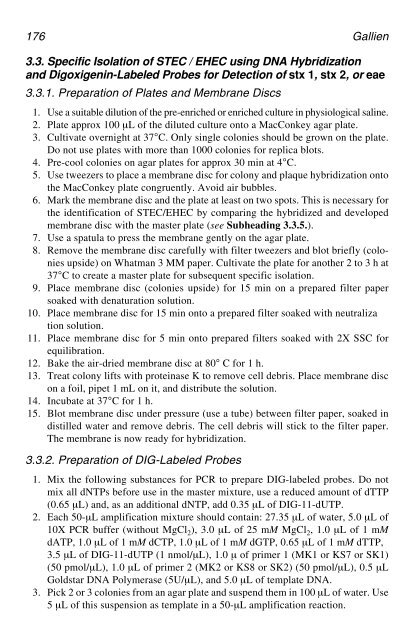PCR Detection of Microbial Pathogens PCR Detection of Microbial ...
PCR Detection of Microbial Pathogens PCR Detection of Microbial ...
PCR Detection of Microbial Pathogens PCR Detection of Microbial ...
You also want an ePaper? Increase the reach of your titles
YUMPU automatically turns print PDFs into web optimized ePapers that Google loves.
176 Gallien<br />
3.3. Specific Isolation <strong>of</strong> STEC / EHEC using DNA Hybridization<br />
and Digoxigenin-Labeled Probes for <strong>Detection</strong> <strong>of</strong> stx 1, stx 2, or eae<br />
3.3.1. Preparation <strong>of</strong> Plates and Membrane Discs<br />
1. Use a suitable dilution <strong>of</strong> the pre-enriched or enriched culture in physiological saline.<br />
2. Plate approx 100 µL <strong>of</strong> the diluted culture onto a MacConkey agar plate.<br />
3. Cultivate overnight at 37°C. Only single colonies should be grown on the plate.<br />
Do not use plates with more than 1000 colonies for replica blots.<br />
4. Pre-cool colonies on agar plates for approx 30 min at 4°C.<br />
5. Use tweezers to place a membrane disc for colony and plaque hybridization onto<br />
the MacConkey plate congruently. Avoid air bubbles.<br />
6. Mark the membrane disc and the plate at least on two spots. This is necessary for<br />
the identification <strong>of</strong> STEC/EHEC by comparing the hybridized and developed<br />
membrane disc with the master plate (see Subheading 3.3.5.).<br />
7. Use a spatula to press the membrane gently on the agar plate.<br />
8. Remove the membrane disc carefully with filter tweezers and blot briefly (colonies<br />
upside) on Whatman 3 MM paper. Cultivate the plate for another 2 to 3 h at<br />
37°C to create a master plate for subsequent specific isolation.<br />
9. Place membrane disc (colonies upside) for 15 min on a prepared filter paper<br />
soaked with denaturation solution.<br />
10. Place membrane disc for 15 min onto a prepared filter soaked with neutraliza<br />
tion solution.<br />
11. Place membrane disc for 5 min onto prepared filters soaked with 2X SSC for<br />
equilibration.<br />
12. Bake the air-dried membrane disc at 80° C for 1 h.<br />
13. Treat colony lifts with proteinase K to remove cell debris. Place membrane disc<br />
on a foil, pipet 1 mL on it, and distribute the solution.<br />
14. Incubate at 37°C for 1 h.<br />
15. Blot membrane disc under pressure (use a tube) between filter paper, soaked in<br />
distilled water and remove debris. The cell debris will stick to the filter paper.<br />
The membrane is now ready for hybridization.<br />
3.3.2. Preparation <strong>of</strong> DIG-Labeled Probes<br />
1. Mix the following substances for <strong>PCR</strong> to prepare DIG-labeled probes. Do not<br />
mix all dNTPs before use in the master mixture, use a reduced amount <strong>of</strong> dTTP<br />
(0.65 µL) and, as an additional dNTP, add 0.35 µL <strong>of</strong> DIG-11-dUTP.<br />
2. Each 50-µL amplification mixture should contain: 27.35 µL <strong>of</strong> water, 5.0 µL <strong>of</strong><br />
10X <strong>PCR</strong> buffer (without MgCl 2), 3.0 µL <strong>of</strong> 25 mM MgCl 2, 1.0 µL <strong>of</strong> 1 mM<br />
dATP, 1.0 µL <strong>of</strong> 1 mM dCTP, 1.0 µL <strong>of</strong> 1 mM dGTP, 0.65 µL <strong>of</strong> 1 mM dTTP,<br />
3.5 µL <strong>of</strong> DIG-11-dUTP (1 nmol/µL), 1.0 µ <strong>of</strong> primer 1 (MK1 or KS7 or SK1)<br />
(50 pmol/µL), 1.0 µL <strong>of</strong> primer 2 (MK2 or KS8 or SK2) (50 pmol/µL), 0.5 µL<br />
Goldstar DNA Polymerase (5U/µL), and 5.0 µL <strong>of</strong> template DNA.<br />
3. Pick 2 or 3 colonies from an agar plate and suspend them in 100 µL <strong>of</strong> water. Use<br />
5 µL <strong>of</strong> this suspension as template in a 50-µL amplification reaction.






